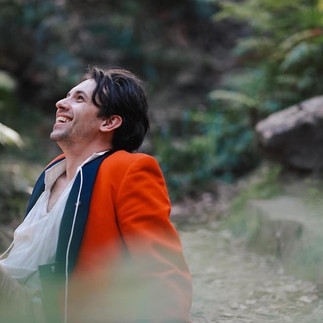Review: The Tempest at The Haven Amphitheatre
- Theatre Travels

- Sep 24, 2022
- 3 min read
Updated: Sep 24, 2022
Review By Laura Heuston
It was Arthur C. Clarke who voiced the idea that “any sufficiently advanced technology is indistinguishable from magic”. And if he was correct on the technological front, I am not sure. But one thing I do know is that if you replaced “sufficiently advanced technology” with “perfect treatment of Shakespeare”, you would be exactly right. Watching Come You Spirits perform The Tempest at dawn of the Spring Equinox is utterly indistinguishable from magic.
You will need to travel into the Castlecrag Reserve in order to encounter these spirits, but the journey is absolutely worth it. The Haven Amphitheatre is our stage, and thus we are immersed in the magic of the forest before any of the spells even take place. Such a beautiful location cannot be overestimated in its importance, especially when engaging with as mystical a text as The Tempest. Our Ferdinand (Alec Ebert) seems to clamber up from the bay once he is wrecked upon the shore, and Caliban (Jo Bloom) emerges from her forest full of wildness and hidden power. The island is of course a source of great energy in the play, and to finally see it in a place that can genuinely reflect such energy allows Shakespeare's language to take on a beauty that would be lost in a lesser setting.
And of course, Come You Spirits are more invested in energy than your average theatre company. Working with qui energy (life force) the company has utilised energy healing light practise to create an experience that spiritually rejuvenates while also entertaining. The settings are based on sacred geometry, and the sound and lighting by Brandon Read is designed to engage with the qui of the audience and space. I have never seen such a spiritual treatment of Shakespeare, and it is truly something to behold. The actors seem to genuinely be at play in their delivery, and as such are able to engage with the purity of feeling that Shakespeare is so brilliantly able to encapsulate. Our lovers (Sontaan Hopson and Alec Ebert) have the childlike wonder of love at first sight struck across their faces, and Prospero’s (Charles Mayer) grief and joy at their wedding is close to us and honest. Whatever your views of energy and spirituality may be, opening your heart to these actors and their practice will not be an emotional let down.
So how do four people manage to produce the emotional depth of a play with triple the characters? By skillfully combining them to create figures of elevated complexity. Miranda was always akin to a forest nymph, and now she takes on elemental powers in Sontaan Hopson’s Ariel. Caliban and Sycorax have a much closer family resemblance than previously depicted, and our heroic Ferdinand has a touch of the drunken Trinculo and Stephano about him. And why not, you may ask? The man has just been shipwrecked after all, that may entitle him to a drink. Such blending of characters allows for our central figures to take on new qualities, establishing contrasts within the people themselves that Shakespeare preferred to use character foils to illustrate. Furthemore, connections that were once only alluded to are now brought to the fore; the fear and respect that Prospero had for Sycorax is now visually illustrated by the liberation of Caliban. This work has been brilliantly devised by the company, and while they may be few in number, they have skill and commitment to Shakespeare in utter abundance.
The Tempest was one of Shakespeare’s last plays, and so it is fitting that one of the central themes is letting go. And of course, the Spring Equinox is a time for growth and rebirth. But in order to grow, we must free ourselves of that which is stifling us. For Prospero, it was his thirst for power and revenge. And as such, he imprisoned everyone else on his island. To watch this story of liberation at the dawn of spring is a powerful reminder of the beauty and essential nature of freedom, to both the human condition and the natural world. Come You Spirits will take you to a place just between the human and the ethereal, to demonstrate just how close we are through language and our connection to the natural world.
Image Credit: Syl Marie















